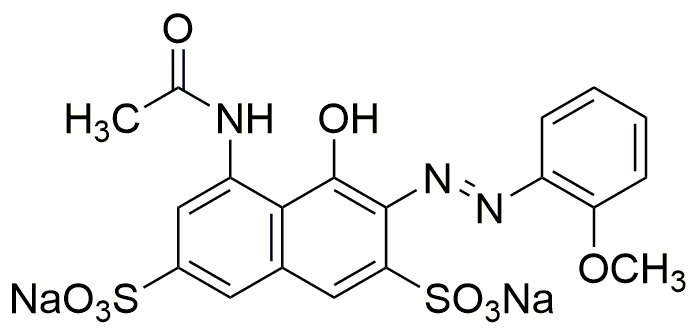Pontacyl carmine 2B is widely utilized in research focused on:
- Biological Staining: This compound is an effective dye for staining biological tissues, helping researchers visualize cellular structures under a microscope. Its vivid color enhances contrast, making it easier to identify specific cell types.
- Food Industry Applications: Used as a food colorant, it provides a vibrant red hue to various products, meeting consumer demand for visually appealing food items while adhering to safety regulations.
- Textile Dyeing: In the textile industry, it serves as a dye for fabrics, offering excellent colorfastness and stability, which is crucial for maintaining the quality of dyed materials over time.
- Cosmetic Formulations: The compound is incorporated into cosmetic products for coloring, providing a safe and attractive option for formulations that require vibrant shades.
- Analytical Chemistry: It is utilized in analytical applications, such as chromatography, where it aids in the separation and identification of various compounds due to its distinct color properties.
General Information
Properties
Safety and Regulations
Applications
Pontacyl carmine 2B is widely utilized in research focused on:
- Biological Staining: This compound is an effective dye for staining biological tissues, helping researchers visualize cellular structures under a microscope. Its vivid color enhances contrast, making it easier to identify specific cell types.
- Food Industry Applications: Used as a food colorant, it provides a vibrant red hue to various products, meeting consumer demand for visually appealing food items while adhering to safety regulations.
- Textile Dyeing: In the textile industry, it serves as a dye for fabrics, offering excellent colorfastness and stability, which is crucial for maintaining the quality of dyed materials over time.
- Cosmetic Formulations: The compound is incorporated into cosmetic products for coloring, providing a safe and attractive option for formulations that require vibrant shades.
- Analytical Chemistry: It is utilized in analytical applications, such as chromatography, where it aids in the separation and identification of various compounds due to its distinct color properties.
Documents
Safety Data Sheets (SDS)
The SDS provides comprehensive safety information on handling, storage, and disposal of the product.
Product Specification (PS)
The PS provides a comprehensive breakdown of the product’s properties, including chemical composition, physical state, purity, and storage requirements. It also details acceptable quality ranges and the product's intended applications.
Certificates of Analysis (COA)
Search for Certificates of Analysis (COA) by entering the products Lot Number. Lot and Batch Numbers can be found on a product’s label following the words ‘Lot’ or ‘Batch’.
Número de catálogo
Número de lote/lote
Certificates Of Origin (COO)
This COO confirms the country where the product was manufactured, and also details the materials and components used in it and whether it is derived from natural, synthetic, or other specific sources. This certificate may be required for customs, trade, and regulatory compliance.
Número de catálogo
Número de lote/lote
Safety Data Sheets (SDS)
The SDS provides comprehensive safety information on handling, storage, and disposal of the product.
DownloadProduct Specification (PS)
The PS provides a comprehensive breakdown of the product’s properties, including chemical composition, physical state, purity, and storage requirements. It also details acceptable quality ranges and the product's intended applications.
DownloadCertificates of Analysis (COA)
Search for Certificates of Analysis (COA) by entering the products Lot Number. Lot and Batch Numbers can be found on a product’s label following the words ‘Lot’ or ‘Batch’.
Número de catálogo
Número de lote/lote
Certificates Of Origin (COO)
This COO confirms the country where the product was manufactured, and also details the materials and components used in it and whether it is derived from natural, synthetic, or other specific sources. This certificate may be required for customs, trade, and regulatory compliance.


